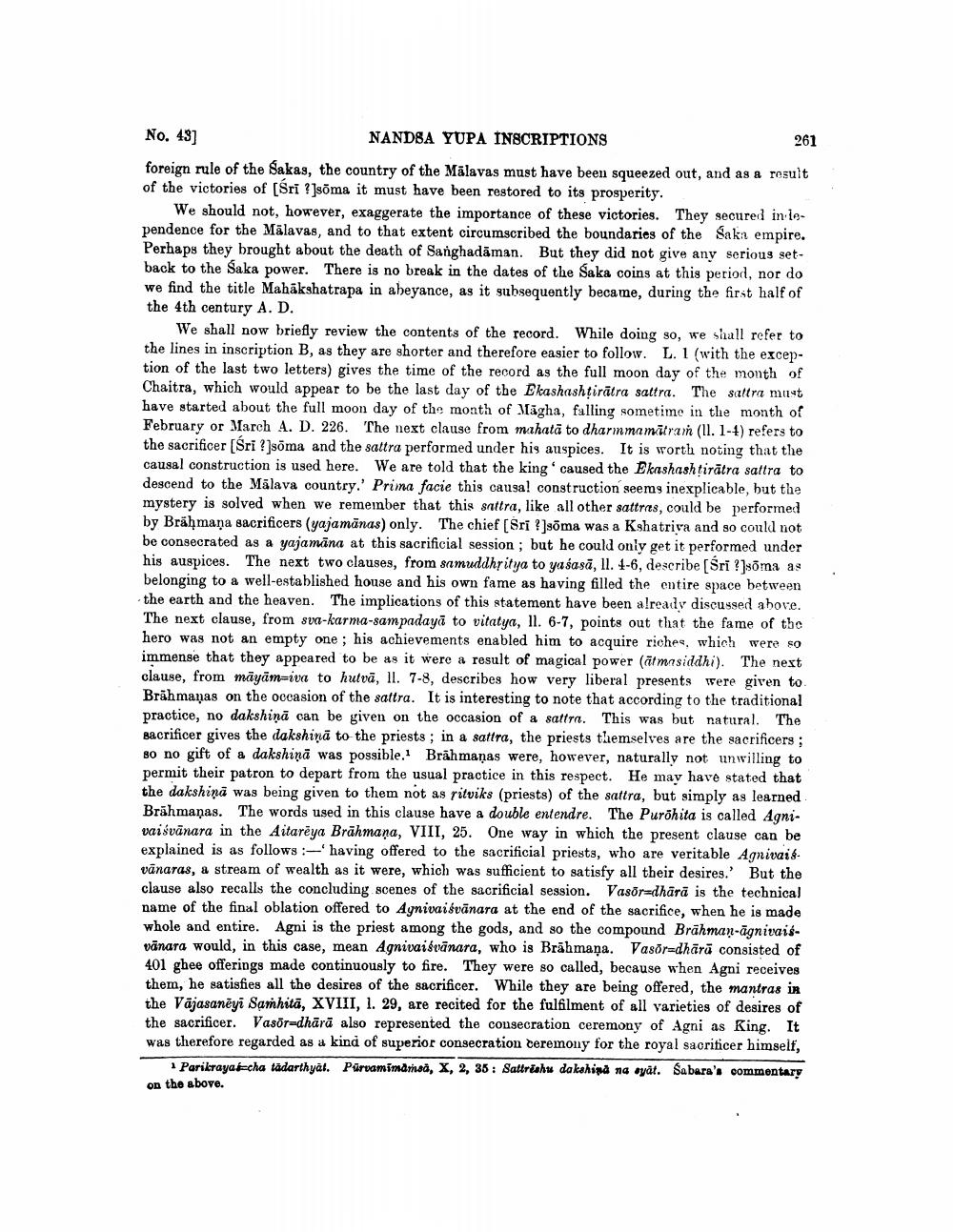________________
No. 43)
NANDSA YUPA INSCRIPTIONS
261
foreign rule of the Sakas, the country of the Mālavas must have been squeezed out, and as a result of the victories of Sri ? Jsoma it must have been restored to its prosperity.
We should not, however, exaggerate the importance of these victories. They secured in lopendence for the Mälavas, and to that extent circumscribed the boundaries of the Saka empire. Perhaps they brought about the death of Sanghadaman. But they did not give any serious setback to the Saka power. There is no break in the dates of the Saka coins at this period, nor do we find the title Mahākshatrapa in abeyance, as it subsequently became, during the first half of the 4th century A. D.
We shall now briefly review the contents of the record. While doing so, we shall refer to the lines in inscription B, as they are shorter and therefore easier to follow. L. 1 (with the exception of the last two letters) gives the time of the record as the full moon day of the month of Chaitra, which would appear to be the last day of the Ekashashtirätra sattra. The sattra must have started about the full moon day of the month of Jägha, falling sometime in the month of February or March A. D. 226. The next clause from mahatā to dharımamitram (11. 1-) refers to the sacrificer (Sri ?]soma and the sattra performed under his auspices. It is worth noting that the causal construction is used here. We are told that the king caused the Ekashashtirātra saftra to descend to the Mālava country.' Prima facie this causal construction seems inexplicable, but the mystery is solved when we remeinber that this sattra, like all other sattres, could be performed by Brāhmaṇa sacrificers (yajamānas) only. The chief (Sri ? Jsoma was a Kshatriya and so could not be consecrated as a yajamāna at this sacrificial session, but he could only get it performed under his auspices. The next two clauses, from samuddhritya to yasasā, II. 4-6, describe (Sri ?lsoma as belonging to a well-established house and his own fame as having filled the entire space between the earth and the heaven. The implications of this statement have been already discussed above. The next clause, from sva-karma-sampadayā to vitatya, 11. 6-7, points out that the fame of the hero was not an empty one ; his achievements enabled him to acquire riches, which were so immense that they appeared to be as it were a result of magical power (atmasiddhi). The next clause, from māyām=iva to hutvā, 11. 7-8, describes how very liberal presents were given to Brāhmaṇas on the occasion of the sattra. It is interesting to note that according to the traditional practice, no dakshinā can be given on the occasion of a satira. This was but natural. The sacrificer gives the dakshina to the priests ; in a sattra, the priests themselves are the sacrificers; 80 no gift of a dakshină was possible. Brāhmaṇas were, however, naturally not unwilling to permit their patron to depart from the usual practice in this respect. He may have stated that the dakshina was being given to them not as ritviks (priests) of the sattra, but simply as learned Brāhmaṇas. The words used in this clause have a double entendre. The Purohita is called Agnivaisvānara in the Aitarēya Brāhmaṇa, VIII, 25. One way in which the present clause can be explained is as follows:- having offered to the sacrificial priests, who are veritable Agnivaid vānaras, a stream of wealth as it were, which was sufficient to satisfy all their desires. But the clause also recalls the concluding scenes of the sacrificial session. Vasöradhara is the technical name of the final oblation offered to Agnivaisvānara at the end of the sacrifice, when he is made whole and entire. Agni is the priest among the gods, and so the compound Brāhman-āgniraisvānara would, in this case, mean Agnivaisvanara, who is Brāhmaṇa. Vasor-dhārā consisted of 401 ghee offerings made continuously to fire. They were so called, because when Agni receives them, he satisfies all the desires of the sacrificer. While they are being offered, the mantras in the Vājasanēyi Samhitā, XVIII, 1. 29, are recited for the fulfilment of all varieties of desires of the sacrificer. Vasör-dhārā also represented the consecration ceremony of Agni as King. It was therefore regarded as a kind of superior consecration ceremony for the royal sacrificer himself,
Pari rayascha tādarthyal. Pürvamimarinsa, X, 2, 35: Sattrishu dakshipa na sat. Sabara's commentary on the above.




